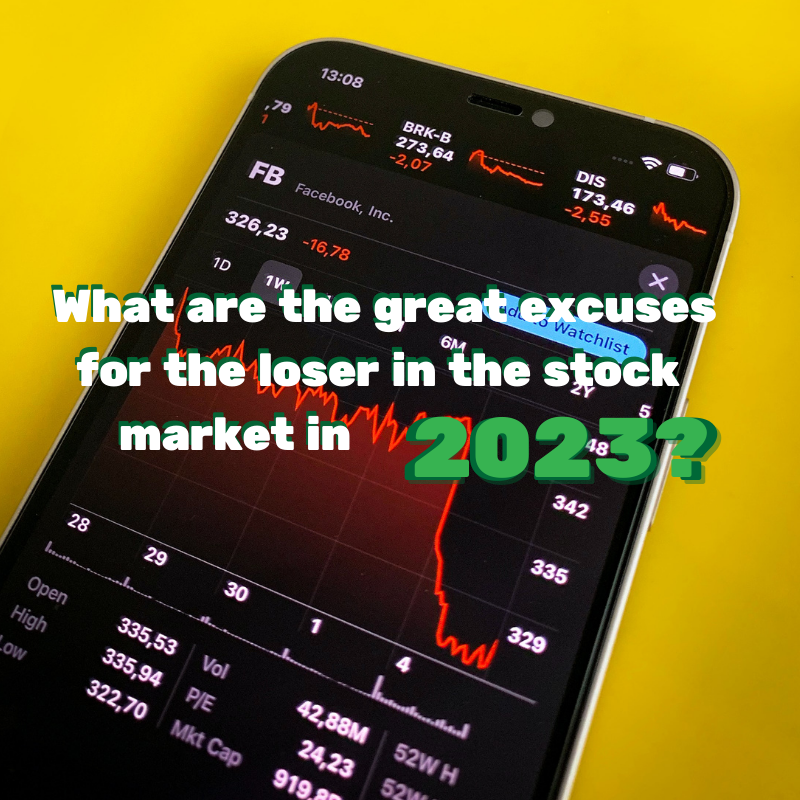No products in the cart.
Financial, Stock Market
Market trends : What are the great excuses for the loser in the stock market in 2023?
Overview
The stock market is one of the few places where items go on sale, yet buyers hesitate to purchase. Unlike other industries where discounts attract more customers, a declining stock price often triggers panic, leading to a wave of selling rather than buying. This paradox stems from emotions overpowering logic, as fear drives investors to sell when prices are low, and greed compels them to buy when prices are soaring.
This behavior is evident whenever there is a minor percentage shift in stock prices. A slight dip in the market can cause investors to panic and offload their shares, fearing further losses. On the other hand, when prices rise, there is a herd mentality, and people rush to invest—often justifying their decisions with commonly repeated rationalizations, regardless of whether the investment is actually a sound one.
The irony is that this approach contradicts the fundamental rule of investing: “Buy low, sell high.” Yet, time and time again, investors do the opposite. They buy when stocks are expensive out of fear of missing out (FOMO) and sell when prices are low due to anxiety about further declines. This pattern repeats across market cycles, preventing many individuals from maximizing their returns.
Understanding this phenomenon is crucial for anyone looking to build long-term wealth. Successful investors recognize the importance of staying calm during downturns, resisting emotional impulses, and focusing on the bigger picture rather than short-term market fluctuations.
Here are the great excuses of the losers in the stock market trading:
First excuse: “I no longer enjoy these shares, so I’m selling.”
Many investors fall into the trap of making impulsive decisions based on emotions rather than rational analysis. They justify their actions with statements like, “I no longer enjoy these shares,” when in reality, their decisions are often driven by the thrill of short-term trading rather than sound investment principles.
The desire for constant excitement can be misleading, as it reinforces the belief that frequent buying and selling is necessary to achieve substantial returns. However, successful investing is not about constant action—it’s about patience, discipline, and long-term commitment.
The Reality of Long-Term Investing
While short-term trading may seem appealing, the reality is that holding onto quality investments for an extended period is one of the most reliable ways to build wealth. The most common mistake investors make is trying to time their entry and exit points, often reacting to market fluctuations instead of focusing on the long-term potential of their holdings.
In fact, historical data shows that most investors who jump in and out of investments at the wrong times miss key opportunities for significant growth. By selling too soon, they cut themselves off from the compounding effect of reinvested earnings and dividends, which are crucial for wealth accumulation.
Why Holding Long-Term Pays Off
The best way to benefit from high-performing companies is to stay invested and allow their growth to work in your favor. Over time, successful businesses tend to increase their revenues and expand their market presence, leading to higher valuations. As earnings grow, the value of shares also rises, generating greater returns for those who stay patient.
The Key to Sustainable Profits
If the goal is to maximize financial gains, then holding onto investments in fundamentally strong businesses is the best approach. These companies tend to weather economic fluctuations better and consistently deliver value to their investors. Instead of making impulsive decisions based on temporary emotions, a well-thought-out strategy that prioritizes long-term wealth creation is the smarter choice.
Second Excuse: “I’ll reinvest when the price is lower next week”
Many investors convince themselves that they can time their next investment perfectly, believing that waiting for a lower price will lead to a better deal. However, this overconfidence in predicting short-term price movements can be misleading. The reality is that price fluctuations are unpredictable, and attempting to forecast them often leads to missed opportunities.
Why Investors Fall Into This Trap
This mindset is usually influenced by one of two psychological factors:
Greed – The desire to secure the absolute best price, leading to endless waiting for a “perfect” buying moment.
Fear – A sense of hesitation, stemming from concerns about potential short-term losses if prices drop after an investment.
Both of these emotions can prevent individuals from making rational investment decisions, keeping them stuck on the sidelines instead of taking action.
The Risk of Waiting Too Long
Because short-term price movements are impossible to predict, waiting for the “ideal” moment can backfire. Prices might rise unexpectedly, forcing hesitant investors to either buy at a higher price or miss out entirely.
Even if prices do decline temporarily, there’s no guarantee that an investor will have the confidence to act at that moment—many who wait for a dip often panic when it actually happens and continue postponing their investment.
A More Effective Strategy
Rather than trying to predict short-term price swings, a better approach is to invest systematically over time. By following disciplined investment strategies such as dollar-cost averaging, investors can reduce the impact of price volatility and avoid making emotionally driven decisions.
Instead of chasing short-term dips, focusing on consistent, well-planned investments is far more likely to lead to long-term financial success.
Third Excuse: “I’d rather hold off on making investments until the market is secure enough.”
This reasoning often emerges after a period of decline, whether it’s a temporary dip or a prolonged downturn. Investors convince themselves that waiting for a sense of stability will protect them from further losses. However, what they truly mean is that they are waiting for prices to rise again—which ironically means they will end up paying more for the same investments they hesitated to buy earlier.
The Psychology Behind This Excuse
This mindset is primarily driven by loss aversion, a well-documented psychological bias where people fear losses more than they value equivalent gains. In simpler terms, the pain of losing money is felt more intensely than the pleasure of making a profit, leading investors to prioritize avoiding short-term losses over securing long-term growth opportunities.
Why This Approach Can Backfire
By delaying their investment decisions until conditions “feel safe”, individuals often miss out on prime buying opportunities that arise when prices are lower. The irony is that by the time they feel confident again, prices have already increased, meaning they have to invest at a higher cost and reduce their potential gains.
For example:
Imagine an investor who planned to buy shares of a well-established company at $50 per share but decided to wait until the “right time.” Due to market uncertainty, they postponed their investment. A few months later, once the economy showed signs of recovery, the stock price rose to $70 per share. By the time they finally invested, they had lost the opportunity to buy at a lower price, reducing their potential return on investment.
A Smarter Alternative
Instead of waiting for an illusion of certainty, experienced investors focus on long-term trends rather than short-term fluctuations. A well-thought-out strategy—such as gradually investing over time through dollar-cost averaging—helps mitigate risk and allows investments to benefit from recoveries instead of missing them.
How to Overcome This Excuse
Educate Yourself: Understanding that markets move in cycles can help investors avoid hesitation. No period of stability lasts forever, and neither does volatility.
Set Clear Goals: Rather than reacting emotionally, establish a structured investment plan that aligns with your financial objectives.
Embrace Volatility: Market downturns often present discounted buying opportunities, so instead of fearing declines, consider them as chances to buy strong assets at lower prices.
Take Action: Start with small investments rather than waiting indefinitely. By doing so, you gradually build confidence while benefiting from future price recoveries.
By recognizing the trap of loss aversion, investors can shift their mindset from fear-based hesitation to strategic decision-making, ultimately improving their chances of achieving financial growth and long-term wealth accumulation.

Over time, historical data and investment studies have shown that investors who maintain a long-term approach and resist the urge to frequently monitor or tweak their portfolios tend to achieve significantly higher returns than those who attempt to time the market. In fact, it can be demonstrated that if an investor simply holds onto their investments without making impulsive decisions based on short-term volatility, they may earn at least twice as much as someone who invests sporadically—perhaps less than once a year—and then exits the market at the wrong time due to uncertainty or panic.
This happens because markets do not move in a straight line. There are periods of growth, corrections, and unexpected downturns, but in the long run, the overall trajectory has historically been upward. The challenge is that the most crucial days for growth are impossible to predict in advance. Even missing just a handful of these high-growth days can have a substantial negative impact on an investor’s overall returns. For instance, studies have found that missing the top 10 best-performing days in a decade can slash investment returns by half.
Because of this unpredictability, the only reliable way to maximize gains is to stay invested. This strategy ensures that investors are always positioned to benefit from the market’s best-performing days without having to stress over daily price swings. By avoiding the temptation to react to short-term fluctuations and instead focusing on long-term value, investors put themselves in the best position to grow their wealth over time.
READ MORE RELATED BLOGS!
READ MORE AND SHARE!
TSOK Chronicles: Unleashing Passion, Dedication, and Excellence in 2024
2023 Your Practical Wedding Guide
Investments and Finance Ultimate Guide
If you like this article please share and love my page DIARYNIGRACIA PAGE Questions, suggestions send me at diarynigracia@gmail.com
You may also follow my Instagram account featuring microliterature #microlit. For more of my artworks, visit DIARYNIGRACIA INSTAGRAM


Peace and love to you.